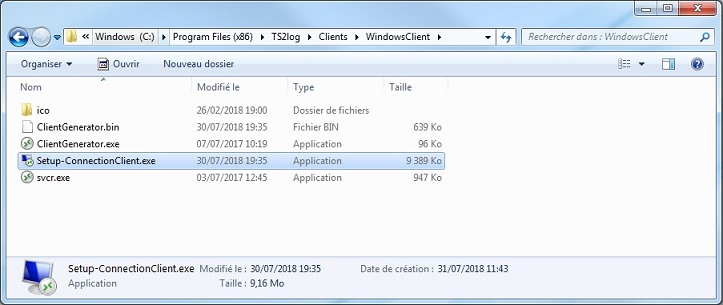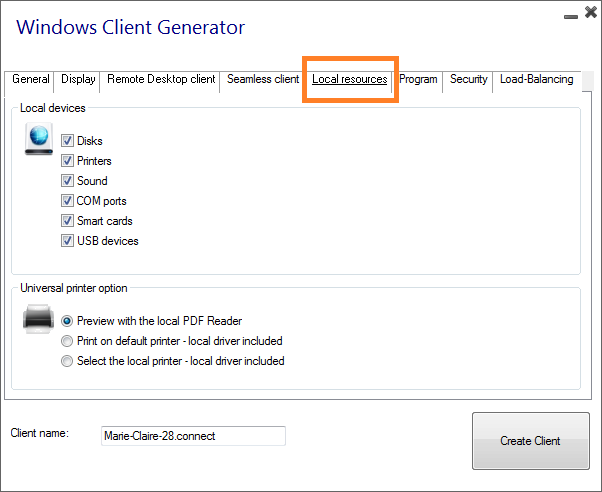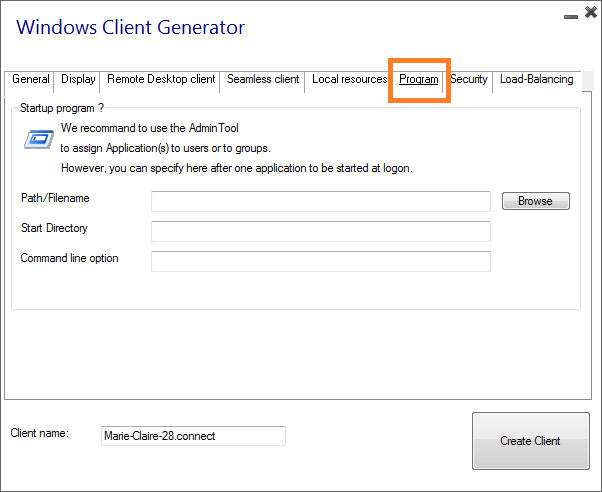Portable Client Generator
Overview
TS2log creates by default an icon for the Portable Client Generator:
![]()
It is also possible to access it by the Server's tile of the AdminTool:
![]()
It enables you to create 3 types of connection clients which can be copied to the users' Desktop or onto a USB stick for portable use.
Since TS2log 11.40 release, the client generator has been redesigned to be numerically signed and to avoid false/positive antiviruses reactions.
Instead of a ".exe" program, the new Client Generator is creating a flat encrypted file with the extension ".connect":
![]()
Pre-requisite on Client' side
On client’ side, each user will have to run a signed program named "Setup-ConnectionClient.exe” as a pre-requisite. This program is available on your server, in the TS2log program folder: TS2log\Clients\WindowsClient:

or by downloading it.
Detailed Overview
Click on a tab to go to the corresponding information:

Main window - General Settings - General tab
When you launch the client generator, the first tab displayed is the general tab. You will find here all of the essential connection settings that you need to start.
Server Address: Enter the IP address of the server you would like the client to connect to.
Port Number: Enter the server port number. The default value is 3389.
Username and Password: If you enter a username and password, the client program will not ask the user to retype it at each session.
To reset this logon/password saving, you must create and edit a shortcut of the Remote Desktop Client and add the -reset on switch at the end of the target field.
Credentials
- If you don't want to save credentials, enter "nosavecredential" in the logon field of the Portable Client Generator.
- If you don't want to display the logon window with the user name, password and domain name, simply enter "nopassword" on the password field.
- If you want to enable autologon, enter *SSO in the username and password fields.
- If you want the current local user's name to be displayed as a logon for the session, enter **, or %USERNAME% in the logon field.
Domain name: Enter a domain name if any.
Preferred Display Mode: You can choose your preferred Display Mode from the following options:
The Classic Remote Desktop, displaying your remote session environment.
The Microsoft RemoteApp connection client, to display your remote applications as if they were installed locally. It has a better graphic performance over minimized applications.
The Seamless Client, which works the same as RemoteApp, but for older versions of Windows such as Windows XP and 2003.
TS2log Seamless Client vs Microsoft RemoteApp
Microsoft RemoteApp is a Microsoft feature which requires Windows 7 Enterprise or Ultimate, Windows 8 Enterprise or W 2008 / W2012 / W2016.
All users PCs must have at least a RDP6 client. Unlike the Seamless client, the RemoteApp connection client does not depend on the transparency color settings.
You can change the RemoteApp client display and Printing preferences on the Web tab of the Admintool. Minimized applications can be directly found inside the Windows taskbar, like local applications.
TS2log Seamless Client delivers a similar user experience and is available on any Windows host system.
Based on one transparency color selected by the Administrator, the Microsoft Remote Desktop is not displayed anymore and the user will just see his published applications.
The Seamless color can be modified and must be the same when using the AdminTool and the Portable Client Generator.
- Network speed: You can choose between two options depending on your network speed:
- Disable background display & graphic animations for low speed networks.
- Enable background display and graphic animations for fiber optic or fast network.
- Client name: You can name your client as you wish.
DISPLAY tab

On this tab, you can change the color and the session screen resolution.
You can also adapt your session for dual-screens, extend or adjust it automatically and you can activate the TAB key in the session.
Remote Desktop Client features
On this tab, you can choose which resolution you want to enable for the user:

You can check the boxes to enable smart-sizing of the Remote Desktop and if you want the Remote Desktop not to hide or overlap the local taskbar.
Local Resources tab

The local resources tab gathers all the devices that you may redirect in your remote session.
Printers correspond to LPT ports, and COM Ports correspond to Serial Ports.
Below, you can choose your option for printing, with the universal printer:
- PDF preview: The document will be rendered as a PDF and the local Acrobat Reader will open the PDF generated file. The user can print it or save a copy on his local disk drive.
- Printing on the user's default printer: the document will be automatically pushed to the user's default printer (the local print driver is included in the TS2log connection client).
- Select a local printer: The user can select one of his local printers (the local print driver is included in the TS2log connection client).
Program

You can set a startup application via the Portable Client Generator, and specify its path, directory and parameters, since the 11.30 release.
However, we recommend you to use the AdminTool to assign the desired applications.
Security
TS2log offers two extra layers of physical security to keep your users' connections safe.
The connection can be locked to the ID of a USB key, locked to a computer name, or you can use both layers of security simultaneously.
If locked to a USB key, the user can initiate a connection from any qualifying windows computer by inserting the USB key and using the connection program placed there by the administrator.
If locked to a computer name, the user can only connect from the computer whose name has been registered with the server for that user's portable client connection. If both security options are used, the user is limited to connecting from his/her specific device and only if the correct pre-configured USB key is in place.
In order to lock a connection client onto a USB key, you can do so by copying the client generator located in : C:\Program Files (x86)\TS2log\Clients\WindowsClient
Now double click on the client generator and check on "Lock it on serial number" box located on the security tab. Once it is done, you can delete the client generator from the USB key.
The newly generated connection client will be placed on the desktop, don't forget to copy it back to the USB key! You can delete the client generator that you copied on the USB key afterwards.

- You can define the time limit from the first use date of a generated client by entering the value on the time limit box. (which is by default set to "no limit").
- The checkbox (framed in blue) enables you to not display the ability to save credentials for a generated client.
Web Portal Gateway
You can also enable the Load Balancing to connect to one server of your farm.
Do not check the "Use Gateway" box if you did not activate the Load-Balancing feature on your server.
You will need to enter the Web Portal Gateway port, which should be the same as the default web port used on all the servers of your farm.

